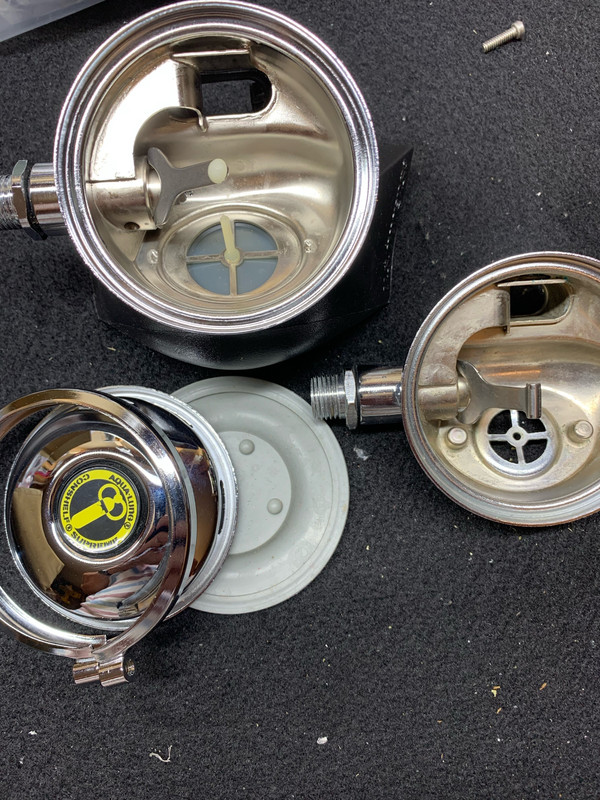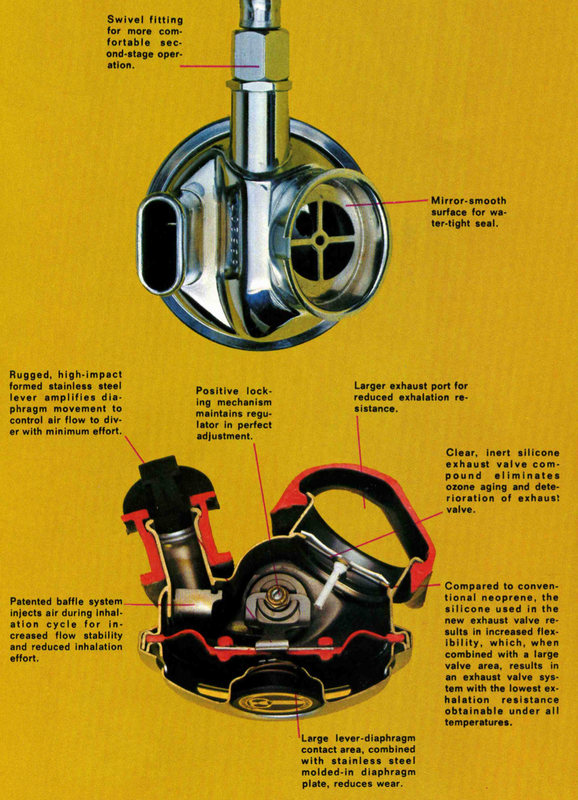Where did you get the Carbon Fiber covers. I really like those!What? Oh baloney macaroni. "Healthy" as how do you come up with this? We are just going to have to agree to disagree. You have opinions based on your prejudices to justify an untenable position and I can appreciate that you do based on your life experiences. But again, the breathing cycle and WOB consists of three parameters:
Cracking effort
Venturi and inhalation effort
Exhaust and exhalation effort
Picking on the 109 is never popular, it is a pretty regulator, and a favorite because it is simple to work on and parts supported and it is factually a very good regulator and to this day at least it can be serviced and dived with confidence. But it does have a measurably higher exhaust effort compared to newer regulators and while not important to you exhaust effort is a consideration in WOB and I notice it most assuredly.
Just for a fun comparison, even more dramatic than the 109 and CE BA 156 comparison, AL must have decided the 1085 was unhealthy enough that they stuck a huge in comparison to the original exhaust valve in and then redesigned a much larger exhaust tee on the regulator and added a plenum. The original 1085 was judged to have been very unhealthy.
It is infuriating when scuba shops are purposely obtuse and refuse to service regulators for customers that still are serviceable and perform well, or, in the case of the Scubapro 109, well enough. Sometimes just being a pretty face is enough and makes up for other short comings
. The G250 et al is ugly looking and industrial but it has a pretty soul. Pretty is as pretty does.

You are using an out of date browser. It may not display this or other websites correctly.
You should upgrade or use an alternative browser.
You should upgrade or use an alternative browser.
Are Converted Scubapro 109's a weak link?
- Thread starter Justin Phillips
- Start date
Please register or login
Welcome to ScubaBoard, the world's largest scuba diving community. Registration is not required to read the forums, but we encourage you to join. Joining has its benefits and enables you to participate in the discussions.
Benefits of registering include
- Ability to post and comment on topics and discussions.
- A Free photo gallery to share your dive photos with the world.
- You can make this box go away
Where did you get the Carbon Fiber covers. I really like those!
Thanks, I like them too. I was cruising about the www looking for someone who was wrong on the internet like Angelo
 and was on a Japanese forum and saw some G250 regulators with cool carbon fiber covers. After a bit of thought I realized that they were not carbon fiber but had been hydro-dipped. So, I hydro-dipped them myself. Easy, you too can show off your new G250s and fool people into thinking you have super cool carbon fiber G250s!!!
and was on a Japanese forum and saw some G250 regulators with cool carbon fiber covers. After a bit of thought I realized that they were not carbon fiber but had been hydro-dipped. So, I hydro-dipped them myself. Easy, you too can show off your new G250s and fool people into thinking you have super cool carbon fiber G250s!!!Yep, they fooled me.. Show off your new G250s and fool people into thinking you have super cool carbon fiber G250s!!!
Too much effort for the other people to look at and admire.
very nice though.
- Messages
- 17,266
- Reaction score
- 9,466
- Location
- Somewhere between here and there
- # of dives
- 2500 - 4999
For ¥59,000 you could buy these 



That picture was my inspiration for my carbon fiber G250s ( ref. post 62). Pretty sure those are also hydro-dipped as I recognize the films. This film here or similar with a gold metallic base coat:
I used a smoke silver grey metallic base coat. There may be a difference, mine are cleared with an industrial urethane that is about as bullet proof as a coating can be.
- Messages
- 17,266
- Reaction score
- 9,466
- Location
- Somewhere between here and there
- # of dives
- 2500 - 4999
Yes, if you look closely you can see the film peeling off the black one. He's been trying to sell them for well over a year, he's dreaming.That picture was my inspiration for my carbon fiber G250s. Pretty sure those are also hydro-dipped as I recognize the films. This film here or similar with a gold metallic base coat:
There may be a difference, mine are shot with an industrial urethane that is about as bullet proof as a coating can be.
If the film is peeling he did not properly prep the covers. Plastics can be difficult but the G250 cover is not so bad to get good adhesion. The Scubapro Hot covers, at least mine, appear to be acrylic, and then hand painted, so they said. The standard G250 case is a carbon infused polyamide (nylon) with 30% glass fiber, an easy substrate to prep. This material does not really need to be flamed for adhesion but I did it anyways, just because I like playing with fireYes, if you look closely you can see the film peeling off the black one. He's been trying to sell them for well over a year, he's dreaming.
The peeling could be a result, not of film or base coat adhesion failure, but of having not completely removed the film residue before clear coating. The film is the water soluble carrier for the dipping inks. It must be removed with a good rinse after dipping and before coating.
At the time Scubaoro released a technical note describing the upgrade of 109 to BA. It was a modification openly supported by Scubapro.There's a difference between an individual servicing a reg thats been converted to something other than what they were originally, and a dive shop servicing them who needs to follow manufactures service guides, tsbs, etc in order to maintain liability coverage if something goes wrong.
Can you imagine the amount of lawyers that would come out of the woodwork if someone had an accident on a 'converted' 109?
Same reason why they didn't want to work on the mk25 with mk10 yoke. Are they the same? probobly. Does scubapro say they're compatible? No.
The same happened for upgranding a MK10 to MK10 plus, A G250 to a G250 HP, etc.
Official upgrade kits were also in the catalog of parts.
They are not anymore available, unfortunately.
But the parts required for the upgrade can be ordered singularly.
Old repair technicians who were trained by Scubapro in the eighties, as me, have no problems servicing these regs using upgraded but compatible parts and following the technical documents released by Scubapro.
Younger technicians trained recently possibly were not taught about these upgrades, so it can well happen that a shop is not willing to service these old 109.
If you do not want to service yourself, you need to find an old technician.
There are some here on SB.
However be sure that using these old regs is perfectly safe and lawful, if they are properly maintained.
Aloha Joe
Contributor
I have a near mint 109 with brand new BA conversion parts, paired with a near mint 250, with cracking effort tuned near identical. The 250 is louder, but more enjoyable to breathe from due to the larger exhalation valve and the Venturi. It’s not a huge difference but it’s noticeable. All that said I like the weight, size, and sound of the 109 so that’s what’s on my primary. But I do dislike the small exhaust valve and exhale through my nose or around my mouthpiece a lot. I would still choose my 109s over any new mid-tier reg from any other scuba brand.
The G250 and the 109 and 156BA use the same demand diaphragm, I find them interchangeable up to the G260. The G250, G260 and 156 (CE) BA use the same exhaust valve, I find them basically interchangeable even if the PNs change. The 109 has a much smaller exhaust valve thus not interchageable.I have a near mint 109 with brand new BA conversion parts, paired with a near mint 250, with cracking effort tuned near identical. The 250 is louder, but more enjoyable to breathe from due to the larger diaphragm, larger exhalation valve, and the Venturi. It’s not a huge difference but it’s noticeable. All that said I like the weight, size, and sound of the 109 so that’s what’s on my primary. But I do dislike the small exhaust valve and exhale through my nose or around my mouthpiece a lot. I would still choose my 109s over any new mid-tier reg from any other scuba brand.
I am not really understanding the loudness concern? Bubbles by your ears? The Venturi? I am somewhat sensitive to noise and exhaust bubbles do aggravate my (minor) tinnitus (I wear a beanie or hood to mitigate). I do not find any difference in noise level between these regulators. As to weight, I think the G250 is lighter in the water than the 109/156 and even the G260.
Similar threads
- Replies
- 25
- Views
- 2,721
- Replies
- 8
- Views
- 376






